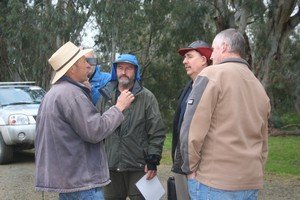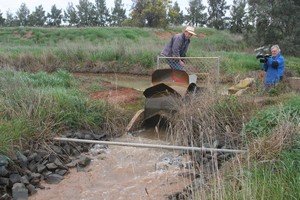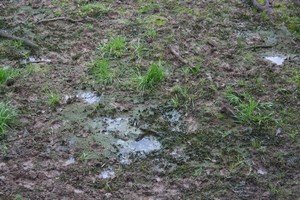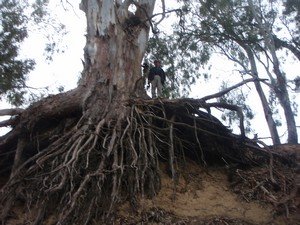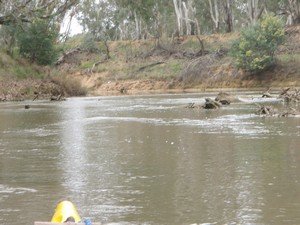Day Two - Past Tongala.
It was an early start to get back out on the river to interview some local farmers this morning. They made some valid points about injustices but I was keen to get going.
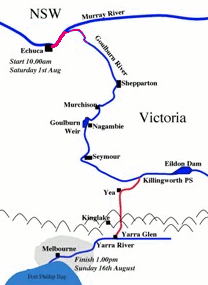 The river throws a lot of obstacles up but in the main they are just plain hard work. I didnít get out of the kayak and only two places needed to knuckle it (push forwards with my knuckles) and didnít even look like capsizing so it was a pretty good day.
The river throws a lot of obstacles up but in the main they are just plain hard work. I didnít get out of the kayak and only two places needed to knuckle it (push forwards with my knuckles) and didnít even look like capsizing so it was a pretty good day.
The log was 73.6km so we didnít quite make 40km for the day but it wasnít too bad for day two with fast flow coming against me about every two kilometres it wasnít too bad.
From Giovanni
We started the day with Peter Hacon and his family whose home paddock Steve had stopped on the night before.
Peter is an intelligent and thoughtful irrigator with an interest in history and piercing blue eyes that support his fatherís assertion that they are members of the Norwegian Royal Family.
He took us around the property to give us an overview of how irrigation in Northern Victoria has developed over the last century and what the latest round of change entail.
Once itís explained, itís all fairly straightforward and, with the benefit of Peterís wisdom, the various sorts of farming layouts we see begin to fit a general picture.
A century of irrigation
Fairly self evidently, the first round of irrigation in mid 19th century was a modification of the natural systems. The billabongs, anabranches and other natural water bearing formations were modified to allow a degree of control over when the water flowed.
Fundamentally they were blocked at the point where water flows back into the river so that rain falling in wet seasons could be held on the high land above the bank and used in dry weather. This meant that these intermittent water holes became permanent and some wildlife Ė ducks, tortises and some fish Ė thrived in the permanent water holes.
Most of the older farms depend on these reservoirs for their basic stock and station water. This is the water that keeps people and animals alive as opposed to the water used to produce food for people who live in the cities.
Any flood water coming across the land that could not be held in these structures is known as outfall. The concrete spillways that were built on the face of the earth walls put at the end of these watercourses to prevent erosion are known as the outfall.
The next stage of development, which was largely carried out after the second world war, was the construction of irrigation channels that criss cross the landscape in a classic grid, carrying water out from the river, or large man-made reservoirs built for the purpose into the hinterland.
See day 4 for more
